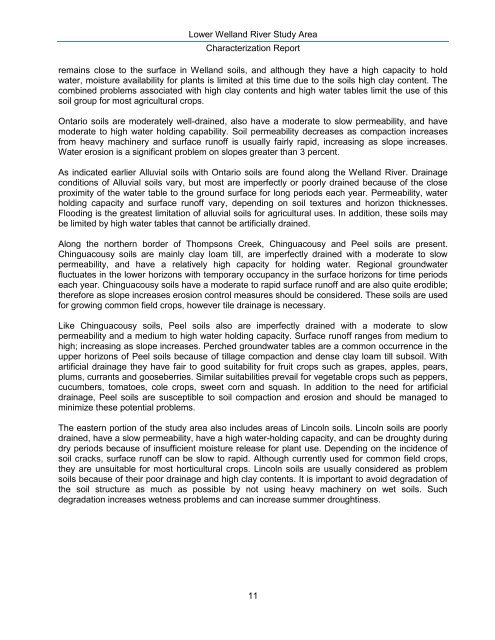Lower Welland River Characterization Report - Niagara Peninsula ...
Lower Welland River Characterization Report - Niagara Peninsula ...
Lower Welland River Characterization Report - Niagara Peninsula ...
You also want an ePaper? Increase the reach of your titles
YUMPU automatically turns print PDFs into web optimized ePapers that Google loves.
<strong>Lower</strong> <strong>Welland</strong> <strong>River</strong> Study Area<br />
<strong>Characterization</strong> <strong>Report</strong><br />
remains close to the surface in <strong>Welland</strong> soils, and although they have a high capacity to hold<br />
water, moisture availability for plants is limited at this time due to the soils high clay content. The<br />
combined problems associated with high clay contents and high water tables limit the use of this<br />
soil group for most agricultural crops.<br />
Ontario soils are moderately well-drained, also have a moderate to slow permeability, and have<br />
moderate to high water holding capability. Soil permeability decreases as compaction increases<br />
from heavy machinery and surface runoff is usually fairly rapid, increasing as slope increases.<br />
Water erosion is a significant problem on slopes greater than 3 percent.<br />
As indicated earlier Alluvial soils with Ontario soils are found along the <strong>Welland</strong> <strong>River</strong>. Drainage<br />
conditions of Alluvial soils vary, but most are imperfectly or poorly drained because of the close<br />
proximity of the water table to the ground surface for long periods each year. Permeability, water<br />
holding capacity and surface runoff vary, depending on soil textures and horizon thicknesses.<br />
Flooding is the greatest limitation of alluvial soils for agricultural uses. In addition, these soils may<br />
be limited by high water tables that cannot be artificially drained.<br />
Along the northern border of Thompsons Creek, Chinguacousy and Peel soils are present.<br />
Chinguacousy soils are mainly clay loam till, are imperfectly drained with a moderate to slow<br />
permeability, and have a relatively high capacity for holding water. Regional groundwater<br />
fluctuates in the lower horizons with temporary occupancy in the surface horizons for time periods<br />
each year. Chinguacousy soils have a moderate to rapid surface runoff and are also quite erodible;<br />
therefore as slope increases erosion control measures should be considered. These soils are used<br />
for growing common field crops, however tile drainage is necessary.<br />
Like Chinguacousy soils, Peel soils also are imperfectly drained with a moderate to slow<br />
permeability and a medium to high water holding capacity. Surface runoff ranges from medium to<br />
high; increasing as slope increases. Perched groundwater tables are a common occurrence in the<br />
upper horizons of Peel soils because of tillage compaction and dense clay loam till subsoil. With<br />
artificial drainage they have fair to good suitability for fruit crops such as grapes, apples, pears,<br />
plums, currants and gooseberries. Similar suitabilities prevail for vegetable crops such as peppers,<br />
cucumbers, tomatoes, cole crops, sweet corn and squash. In addition to the need for artificial<br />
drainage, Peel soils are susceptible to soil compaction and erosion and should be managed to<br />
minimize these potential problems.<br />
The eastern portion of the study area also includes areas of Lincoln soils. Lincoln soils are poorly<br />
drained, have a slow permeability, have a high water-holding capacity, and can be droughty during<br />
dry periods because of insufficient moisture release for plant use. Depending on the incidence of<br />
soil cracks, surface runoff can be slow to rapid. Although currently used for common field crops,<br />
they are unsuitable for most horticultural crops. Lincoln soils are usually considered as problem<br />
soils because of their poor drainage and high clay contents. It is important to avoid degradation of<br />
the soil structure as much as possible by not using heavy machinery on wet soils. Such<br />
degradation increases wetness problems and can increase summer droughtiness.<br />
11

















